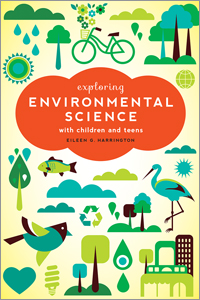Primary tabs
You don't need to be an ALA Member to purchase from the ALA Store, but you'll be asked to create an online account/profile during the checkout to proceed. This Web Account is for both Members and non-Members.
If you are Tax-Exempt, please verify that your account is currently set up as exempt before placing your order, as our new fulfillment center will need current documentation. Learn how to verify here.
- Description
- Table of Contents
- About the author
- Reviews
Despite the abundance of resources on the subject, in the classroom science often takes a back seat to the study of math and English. That gives public and school libraries as well as museums the opportunity to jump in as venues for informal education, sharing the wonders of science with children and their caregivers. In this intriguing book Harrington focuses on environmental science, offering a selection of unique programming ideas that not only entertain but also arm children and teens with information about environmental issues. There's no need to have a particular background in science to use this all-in-one resource, which includes
- Background information on the national state of science education, and how environmental programming can foster science literacy
- Ways to introduce environmental science themes into existing library programs via "Little Learners Labs" for toddlers, science storytimes for young children, and book clubs for tweens and teens
- Lists of age-appropriate titles to share with any group
- Strategies for implementation to ensure success
This book not only demonstrates the need for environmental programming but also gives those who work with children and teens the ideas and confidence they need to move forward.
List of FiguresAcknowledgments Chapter 1 Nurturing Future Environmental Leaders in Libraries and Museums Chapter 2 Reading Roots: Science Storytime (Kindergarten through Third Grade) Chapter 3 Reading for a Greener Future: Book Clubs (Tweens and Teens) Chapter 4 Science Sprouts: Preschool and Kindergarten Programs Chapter 5 Delving Deeper: Self-Guided Activities (All Ages) Chapter 6 Doing Real Science: Citizen Science (Teens and Families with young Children) Chapter 7 Coming Together for Science Fun: Family Science Programs Chapter 8 Environmental Action Clubs (Tweens and Teens) Appendix
Eileen G. Harrington
Eileen G. Harrington is the health and life sciences librarian at the Universities at Shady Grove in Rockville, MD. Previously, she oversaw the Naturalist Center at the California Academy of Sciences, a natural history museum, aquarium, and planetarium. She has served as a reviewer for various manuscripts submitted to Children & Libraries. She has been a formal and informal educator both in the United States and in Latin America and has developed curriculum materials in both English and Spanish. She has a bachelor of arts in environmental studies and biology from Macalester College, St. Paul, MN, a master's degree in environmental studies from York University, Toronto, and a master's degree in library and information studies from the University of Wisconsin–Madison.
"A solid, well-thought out resource."
— School Librarian's Workshop
"This seven-chapter manual is in a very accessible format that can be used as a reference tool, an idea starter, or as a step-by-step guide with exact goals, objectives, methods, and plans for creating environmental science programming for school age youth. As a high school librarian, I find that many programs Harrington presents for younger students can be successfully adjusted to meet the interests and educational levels of tweens, teens, and young adults ... This handbook will be a useful purchase for any library or school. It may begin on a librarian's desk, and later be shared with classroom teachers and youth groups."
— Catholic Library World
"The ready-made programs, activities, real-life examples and lists of print and web-based resources makes this an excellent handbook for teachers, librarians and museum staff who wish to create interesting and appealing science activities for young people."
— Australian Library Journal



